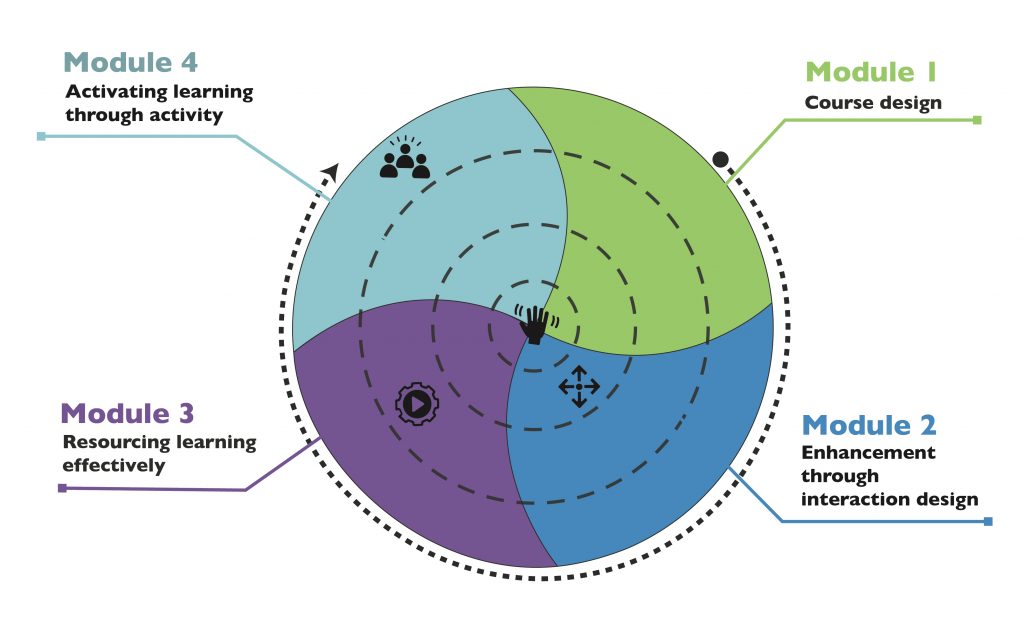A course overview
Before you dive in, let’s take a quick tour through the journey ahead so you know what to expect.

Module 1: Course design
Create and refine a blueprint of your course.
This module focuses on course design where you will create and refine a blueprint for your course. Your blueprint will become an anchor for your journey through the modules, and you will be invited to reflect, refine, and revise the blueprint throughout each week.
Module 2: Enhancement through interaction design
Engage in interactive reinforcement activities (H5P).
This module focuses on enhancing your blueprint through interaction design. You will spend the week learning about expert practices that enhance learner engagement, particularly how designing interactive experiences enhances connections between learners and instructors, and learners and their peers.
Module 3: Resourcing learning effectively
Look at an array of ‘places and spaces’ for learning and the degree to which each can support flexible, hybrid, and fully online/offline experiences.
This module focuses on resourcing learning effectively. You will spend your time getting intentional about the addition of meaningful resources that have a positive impact on learning. Moreover, you will spend some time considering your own blueprint context and how appropriate resources support flexible, hybrid, and fully online/offline experiences.
Module 4: Activating learning through activity
Explore several ‘toolkits’ that demonstrate course themes in action, and analyze these toolkits and their contents to see which activities fit their own teaching.
This module focuses on active learning. This final stage will help you to further enhance your detailed and refined design with effective active learning strategies that fit your learners, your context, and your digital/physical spaces. Finally, you will consider cultivating digital/physical spaces conducive to learner agency.
Each module has four parts:
Introduction![]()
Identifying the ‘location’ of this module within the course level learning, and provide a ‘spark’ to further your module learning.
![]()
Expansion
A worked example is provided to help you apply learning to current course frameworks.
![]() Refinement/Application
Refinement/Application
Each module, by this point, will help you to answer the question ‘How does your learning apply to in-world experiences?’.
![]() Learning community participation
Learning community participation
Share your learning with peers to discuss and provide valuable feedback.
By investing approximately 4 hours each week to course content review and activity you’ll finish the course able to;
- Apply the knowledge, skills, and best resources from this course to the design and structure of your one course;
- Create quality, technology-enhanced (digital) learner experiences;
- Design and develop strategies to realize equity, diversity, and inclusion within digital spaces;
- Design adaptations of pedagogical frameworks for activating learning, within digital spaces
We will begin each of the 4 core modules with a map similar to the one pictured above. It will help to ‘locate’ us in the course and share a bit more about what each section of the module will provide/support. Consider using a consistent approach to your course design. Doing so helps establish learner expectations and eliminates the ‘guess work’ of what is expected each week.
A Course Syllabus
A learner success guide
If you have arrived at this facilitated instance of the Designing Quality Tech-Enabled Learning Experiences course, but are not a participant in a facilitated instance from within your University, perhaps you would prefer to complete the course as a self-directed study.
This course is also available as a self-directed study at the following location: https://ecampusontario.pressbooks.pub/creatingqualitytelexperiencesselfstudy/
EDI refers to equity, diversity, and inclusion. Equity refers to treating learners fairly and respectfully. Diversity refers to diverse representation. Inclusion refers to cultivating an environment where everyone feels welcome and able to fully participate.
theoretical, philosophical, and practical underpinnings that guide and inform instructor's decisions related to teaching and learning such as how learning experiences are design, how learners are assessed, and the strategies instructors use to scaffold instruction
An approach that involves actively engaging students in deep learning to apply and transfer knowledge
Spaces that exists with and through technology.

